Trepashko L. I., Nadtochaeva S. V., Agr. Sci., Pronko А. V.
Institute of plant protection National Academy of Sciences, Belarus
Correspondence to: Trepashko L. I., Institute of plant protection National Academy of Sciences, Belarus.
| Email: |  |
Copyright © 2012 Scientific & Academic Publishing. All Rights Reserved.
Abstract
During 2010-2012 the research on the European corn borer (Ostrinia nubilalis Hbn) – a new corn pest for Belarus – was conducted for the first time. Its area was formed in the southern regions of the country (Gomel and Brest) where the sum of temperatures makes 2200–2600℃. In the central agroclimatic zone the European corn borer harmfulness did not exceed 18 %. Focuses with high phytophage number and harmfulness were found in Brest and Gomel areas in which corn plants were damaged by 94 % and grain losses made 45-60 %. By the results of monitoring, the pest area expansion in the northern areas of Belarus is revealed, the quantity of high number focuses has increased. Studying corn protection measures against the European corn borer has shown that the agrotechnical methods reduced insects number and plant damage by 20 % -46 %., insecticides application during mass egg laying - beginning of caterpillars hatching reduced harmfulness by 76,9-98,7 %, grain yield in these variants has raised by 1,62 – 3,79 t/ha. The obtained results can be used for biological substantiation of the integrated system of crop protection against Ostrinia nubilalis in Belarus.
Keywords:
Ostrinia nubilalis Hb, Corn, Area, Harmfulness, Grain Yield
Cite this paper: Trepashko L. I., Nadtochaeva S. V., Agr. Sci., Pronko А. V., A New Corn Pest - the European Corn Borer(Ostrinia nubilalis Hbn) in Belarus, International Journal of Agriculture and Forestry, Vol. 3 No. 3, 2013, pp. 86-93. doi: 10.5923/j.ijaf.20130303.03.
1. Introduction
In Belarus corn is cultivated for green mass, grain and seeds. Domestic hybrids and varieties breeding has made it the most productive, advantageous and strategic crops. Now the lands under corn crops makes 980 thousand hectares, including those for grain and seeds – 230 thousand hectares. It is the most productive cereal crop in Belarus[1]. However, the phytosanitary situation in corn agrocoenosises has worsened as a result of high number and harmfulness of insects. Till now the basic corn pests are click beetles – wireworms (fam. Elateridae) which damage plants at early stages of development. Recently a new pest for the Republic –Ostrinia nubilalis Hbn. has developed. This phytophage is wide-spread in the USA, Canada and the European countries[2, 3, 4, 5, 6].On the territory of Belarus Ostrinia nubilalis Hbn. has been registered in 1962 in Gomel area, as a hemp pest. This phytophage did not bring an essential damage to corn crops. In the year of 2010 in the southern regions of Gomel and Brest the focuses with a high pest number and plant harmfulness which have caused the essential (up to 45%) crop losses have been registered. As a result of global climate warming, in the Republic ,on the average, for the last 20 years the atmospheric temperature has exceeded the climatic norm for 1,1℃ what has led to 10 days cropping season increase and the active temperatures sums increase for 200℃[7]. It corresponds to 150-200 km advancement by latitude (to the north) of more southern environmental conditions. Saturation of crop rotations by maize, its cultivation throughout many years in one-crop system, non-observance of agrotechnical measures, and also favorable meteorological conditions have favoured the increase of many phytophages harmfulness and, first of all, Ostrinia nubilalis Hbn. According to the references the chemical method of corn protection against the European corn borer till now remains the most effective and is widely used in many countries[4, 5, 8].As main corn areas are concentrated in the southern and central agroclimatic zones of Belarus, this question will be the most actual for corn crops cultivated for seeds and grain in the regions.In the year 2010 Ostrinia nubilalis Hbn. appeared in the list of noxious agricultural crop pests in Belarus. The study covers the questions of occurrence, biology and harmfulness of the European corn borer on the territory of Belarus as well as the measures for its number reduction. The objective of our research was to assess the efficiency of protective measures against the European corn borer (Ostrinia nubilalis Hbn.) number and harmfulness.
2. Materials and Methods
2.1. Site of Research
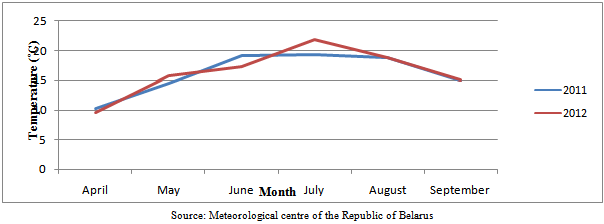 | Figure 1. Monthly average atmospheric temperature during corn vegetation (Brest region, 2011-2012) |
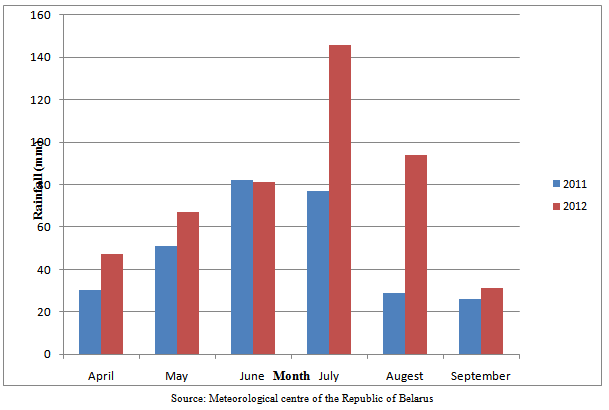 | Figure 2. Rainfall sum during corn vegetation season (2011-2012) |
The research was carried out in 2011-2012. Since the year of 2010 the Ostrinia nubilalis Hbn. has been monitored on maize crops cultivated in different agroclimatic zones. Special trials on harmfulness and chemical measures efficiency evaluation were conducted in the southern agroclimatic zone of Belarus - Brest region, Brest district. The researches on the regulating role of agrotechnical methods were done in Mozyr region Gomel district (52°6'1 "N, 23°40'48" E.The figures 1 and 2 show respectively the average monthly temperatures and rainfall amount throughout maize plants cropping period in Brest region.
2.2. Experimental field Characteristics and Measures for Corn Cultivation
The experimental fields were selected in Brest region Brest district with total area of 90-110 hectares. Before crop sowing ploughing was conducted on those plots at the depth of 20-25 cm. Sowing was done on 20th April, 2011, in 2012 on 29th April at the depth of 5-7 cm, inter-row width -70 cm, sowing rate - 90 thousand seeds per hectare. NPK fertilizers were applied at the rate of 90 kg N, 40 kg P2O5 ,150 K2O per hectare and farmyard manure at the rate of 50 tones per hectare.On experimental plots and control plot there was a background treatment by herbicides at 3 leaves stage against annual dicotyledonous, annual and perennial grass weeds by tank herbicides mixture Kallisto, SС (a.i. 480 g/l Mezothrion ) and Millagro, SC (a.i. 40 g/l Nicosulphuron) (0,15 l/ha + 0,75 l/ha). In Mozyr region Gomel district the research was carried out in order to evaluate the influence of agricultural measures (sowing time, corps residues incorporation, cultivation of monoculture) on the European corn borer harmfulness .
2.3. Methods of Research
Maize phenology was studied on stationary plots, observations were make in certain time intervals[9]. Four stages were observed in each phenological phase:1. Single, if the phase is observed in no more than 5 % of plants;2. The beginning of passing the phase if it is observed in 20 % of plants;3. Mass phase approach if it is marked in more than 50 % of plants;4. End of a phenological phase if it is observed in 80 % of plants.To reveal the pest wintering caterpillars during autumn and spring periods the crop residues were analysed by the method of 100 stems dissection selected in regular intervals in the field diagonally[10, 11]. Time of caterpillars pupation and butterflies flying out was determined by observation in special insectaries where the caterpillars have been placed in crop residues.From 5-6 corn leaves stage period, the egg laying and the caterpillars number were recorded by visual inspection of 10 samples containing 10 plants each located in the field diagonally as well as by plant samples selection with the subsequent dissection[12, 13, 14, 15].The harmfulness was determined during the field trials by model plants labelling, experimental plots isolation and chemical control method[12].The agrotechnical method of plant protection includes a complex of instruments aimed at increasing crop pest resistance as well as preventing pest reproduction.Research on the regulating role of agrotechnical measures was conducted in 2011-2012 on the experimental fields of Forest District Plant-Growing Institute (Mozyrsky region, Gomel district). The European corn borer harmfulness was evaluated on two fields. On the first experimental plot corn was cultivated in a crop rotation where previous crop were graincrops while on the second field – corn was cultivated in the course of five years.On the first plot corn was harvested at a high cut without thorough plant residues incorporation while on the second one – in optimum early time at a low cut with the subsequent cultivation and plant residues incorporation at ploughing. In spring 2011 and 2012 at seedling stage the colonization of plant residues by overwintered caterpillars were observed and recorded.  | Figure 3. Agroclimatic zones of Belarus (Melnik, 2004) |
During the experiments involving protective measures in 2011 the pest number and plant damage records were done according to the following schedule: on 11th July – before treatment; 13th July - the 3rd day after treatment; 17 th July– the 7th day; 24 th July - the 14th day and 23thAugust. - before harvesting, in 2012 - 4th July; 7th July; 11th July; 18th July; 5th September, respectively.For working out the measures against Ostrinia nubilalis special trials were carried out to evaluate biological and economic efficiency of insecticides with different active ingredients: Karate Zeon, МCS (lyambda-cygalothrin), Ampligo, МCS (a.i. lyambda- cygalothrin, 50 g/l + chlorantraniliprol, 100 g/l). In 2011 the insecticides were applied in the period of panicle formation- start of corn flowering stage.Efficiency of chemical measures was estimated according to Methodical instructions on registration tests of insecticides, аcaricides, molluscicides, rodenticides and pheromones in agriculture[12].The economic efficiency calculation was based on preserved grain yield obtained at the cost of protective measures taken in each experimental variant in comparison with the control.
2.4. Agroclimatic Conditions of A Research Site
The territory of Belarus is divided into four agroclimatic zones in accordance with the sum of active temperatures above 10℃ which fluctuate from 2000 to 2600℃ (Figure 3)[7].Considering the fact that for Ostrinia nubilalis Hbn. development the sum of the effective temperatures makes 711℃, III and IV zones are optimum[9, 13, 14].Stationary research was carried out in Brest district, Brest region and Mozyr district, Gomel region. The vegetative season of 2011 in these regions was characterized by temperature regime close to the average perennial parameters. In 2012 warm and moderately humid weather was observed during the whole vegetative season (Figures 1-2).
2.5. The Statistic Analysis
For accuracy and reliability level estimation, the obtained experimental data were statistically processed by dispersive, correlation and regression analysis method[12].
3. Results
3.1. Ostrinia Nubilalis Hbn. spread on the Territory of Belarus
In the year 2010 the European corn borer was found in the Central agroclimatic zone, on 3% of the surveyed area at a low number.In the southern part of the Republic, in Gomel area, Ostrinia nubilalis Hbn. was detected on 8600 hectares of corn crops which is 35 % of the inspected area where plants was colonized from 0,1 to 40 % with the caterpillars and their number made 0,03 - 1 caterpillar per plant. In Brest area the pest was found on 3220 hectares which is 22 % of the inspected crops. Higher number was noted in the southern regions of the area. The plants damage varied from 6 % to 60 %. The highest damages were noted in Maloritsky area on a hybrid Stessi, maize panicle and ears were damaged in 43% of plants. After the harvest of the fields the caterpillars were found on 52 % of the plant leftovers. In 2011 in Central agroclimatic zone (Minsk and Mogilyov areas) the plants damage made 2-6% only. In 2012 according to the results of corn crops inspection on the area of 9920 hectares in different agroclimatic zones, the area of Ostrinia nubilalis Hbn. extended, the focuses with the high pest number increased. By the end of the vegetative season in the southern areas the European corn borer damaged up to 94 % of corn plants, in the Central – up to 18 %.
3.2. The European Corn Borer (Ostrinia Nubilalis Hbn.) Development
During the research years there were favorable conditions for Ostrinia nubilalis Hbn.development. In 2011 in the southern agroclimatic zone the pupation of the overwintered caterpillars started at 8-9 corn leaves stage and lasted for 20 days. Butterflies started to fly, in June when average daily temperature reached 15,1ºC with rainfall amount of 63,5 mm. Females stared laying eggs in the end of June. The hatched caterpillars and plant damages were revealed in the I decade of July at corn panicle formation stage up to the start of blossoming (Table 1) In the year of 2012 the pupation of the overwintered caterpillars started 10 days earlier at 5-6 corn leaves stage. Due to higher average daily temperature (22ºC) the butterflies started to fly on June, 12-14.the first ovipositions were found in the end of June. Due to lower average daily temperature and heavy rainfalls in June-July the caterpillars hatched and started harming the plants in the middle of July (Table 1).Table 1. The European corn borer (Ostrinia nubilalis Hbn) development in Belarus
 |
| |
|
According to the results of monitoring presented in Table 1, during the research years the pest development in more northern regions was 10-15 days later in comparison with their phenology in the southern part of the Republic.
3.3. The European Corn Borer (Ostrinia Nubilalis Hbn.) Harmfulness Under Conditions of Belarus
As a result of the research it is determined that for the last three years Ostrinia nubilalis number and harmfulness has essentially grown. Plant damage in the southern regions of Belarus reached 60%[16]. Harmfulness of insects changed depending on plant development stage, age of caterpillars, time of caused damages which are influenced by weather conditions and the technology of crop cultivation. At corn plant damage some types of Ostrinia nubilalis caterpillars have been identified.While feeding on leaves the hatched caterpillars caused the characteristic damages – windows which were seen under experimental conditions at 8-10 maize leaves development before maize panicle formation. II-III-instar caterpillars damaged maize leaf tube and maize panicles, IV-V-instars damaged corn ear legs and stalks, causing their breaking.During the research years the age structure of Ostrinia nubilalis caterpillars essentially differed in corn ontogenesis which affected their harmfulness.Basing on the given experiments of 2011-2012 on the influence of corn plant damages on grain productivity it is statistically determined that stalk-break below corn ear, reduced the plant weight by 410 g or by 45,1 %, and the corn ear weight – by 280 g, or 55,0 %, which is more essential than the weight loss caused by stalk-break above the corn ear (plant weight loss of 300 g or 33,0%, corn ear weight loss by 250 or by 49,0% (Table 2). The statistic analysis of the obtained data showed the inverse relation between plant damage before harvesting and the obtained grain yield (-0,905) which allowed to calculate the factors of harmfulness, which in 2011 made 0,46 %, in 2012 - 0,24 %.Summing up the above-stated it is possible to draw a conclusion that the maximum phytophage harmfulness is shown at stalks and maize ear damage. In the Southern agroclimatic zone, during two years of research, such type of damages is noted on average in 82,0-86,0 % of corn plants, while in the Central zone it made – 17,0-34,3 %. Table 2. Influence of plant damage by Ostrinia nubilalis on corn yield formation (farming trials, Brest region, 2011-2012)
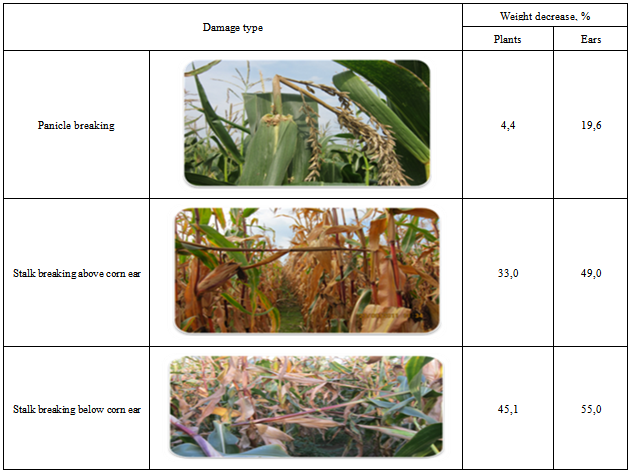 |
| |
|
3.4. Influence of Agrotechnical Methods on European Corn Borer Harmfulness
The results of research have shown that plant residues colonization by pest caterpillars on the corn cultivated in a monoculture made 7,3 % - 18,9%, while its level on the corn cultivated after grain crops made 2,2-2,3 %. In 2011 by stages of corn development, plant severity in the first field at cultivation in a crop rotation has made 35-51 %, in 2012 – 5,0-36 %, in the second plot at cultivation in a monoculture by years 35 % and 51,0 %, 5% and 36,0 % (Table 3), respectively.Thus, the trial results have shown that corn cultivated in a monoculture is damaged more heavily, than corn cultivated in a crop rotation. Agricultural methods that proved effective in reduction of the European corn borer are corn harvesting at low cut with the thorough crushing of plant leftovers and their deep incorporation into the soil[6]. Influence evaluation of the abovementioned agrotechnical methods on the phytophage harmfulness was accomplished on two fields. The records data showed that in the first field the overwintered caterpillars number in plant residues was above 22,2 % and 10 %, in the second – 1,0 % and 1,6 % by years, respectively (Table 4).Inspections on pest development as well as plant severity records were held during crop growing period. As it is presented in the Table 4, the European corn borer harmfulness by trial variants differed essentially. Table 3. Influence of corn cultivation in a crop rotation on plant severity by the European corn borer (Field trials, Mozyrsky region, Gomel district)
 |
| |
|
Table 4. Influence of post-harvest agrotechnical measures on European corn borer number and harmfulness (Field trials, Mozyrsky region, Gomel district)
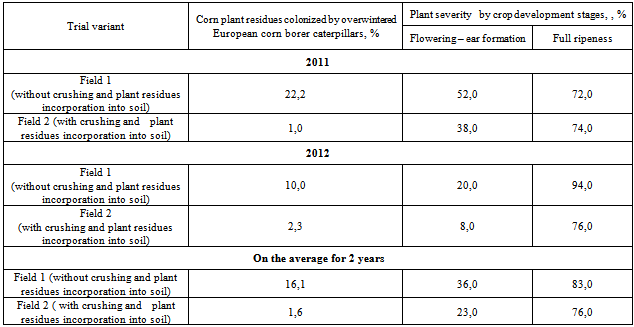 |
| |
|
3.5. Efficiency of Insecticides Against the European Corn Borer
The European corn borer number reached 1,0 indiv. /plant with 14 % plant colonization. In the structure of pest population, the egg laying made 40 %, and 60 %. of the first - instar caterpillars.The results of the research on biological and economic efficiency of the insecticides against the European corn borer are shown in Tables 5-6.Biennial research on the efficiency of insecticides against the European corn borer in corn crops cultivated for grain showed that Ampligo, МСS with the rate of application 0,3 l/ha applied in the period оf egg laying – beginning of caterpillars hatching was the most effective. The grain yield in relation to control has raised for 84,4 and 22,4 %.Table 5. Biological efficiency of insecticides against the European corn borer (farming trials, Brest region Brest district)
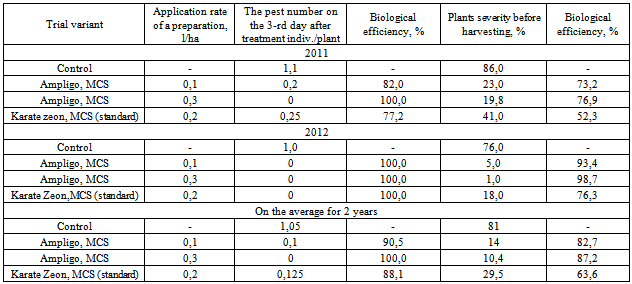 |
| |
|
Table 6. Economic efficiency of insecticides against the European corn borer in corn crops (farming trials , Brest region , Brest district)
 |
| |
|
4. Discussion
It is the first time when the research on the spread, number and harmfulness of the European corn borer is held in Belarus.The analysis of weather conditions of Belarus, biological and ecological features of Ostrinia nubilalis has shown that the amount of thermal energy and the sum of rainfall amount during summer months is enough for the European corn borer development. Especially favorable conditions are developed in southern and new agroclimatic zones which promotes mass development of the pest in these areas. In 2011 plant severity in the southern areas reached 73-76 %. In the central agroclimatic zone (Minsk and Mogilyov areas) only 2-6 % of plants were damaged. As a result of monitoring in Vitebsk region the European corn borer is not revealed. In 2012 by the results of corn crops inspection on the area of 9920 hectares in different agroclimatic zones it is revealed that the area of the European corn borer has extended, the number of focuses with high pest number has increased. By the end of the vegetative season in the southern areas the European corn borer damaged up to 94 % of corn plants, in the central – to 18 %.In order to reduce the European corn borer harmfulness it is necessary: to observe crop rotation, carry out corn harvesting in optimum early times at a low cut with the thorough crushing and plant residues incorporation into the soil.For the corn crops cultivated for grain with high European corn borer number it is expedient to carry out chemical treatments during egg laying and beginning of caterpillars hatching. Application of insecticides Karate Zeon, МСS: (lyambda-cygalothrin), Ampligo, МCS (a.i. lyambda- cygalothrin, 50 g/l + chlorantraniliprol, 100 g/l). showed that the highest effect is received in a variant where Ampligo, МСS is applied at the rate of 0,3 l/ha. The obtained results can be used for biological substantiation and integrated system of corn protection against the European corn borer development in Belarus.
5. Conclusions
The European corn borer area is formed on the territory of new, southern and central agroclimatic zones of Belarus.As a result of the European corn borer monitoring the pest area expansion in northern regions is revealed which is connected to the climate warming and corn cultivation on a large territory.In the southern regions of the Republic in 2011-2012 the focuses with high Ostrinia nubilalis number and harmfulness are found, which caused corn grain losses of 1,2 – 3.8 t/ha. The grain yield decreased more essentially with the damage by stalk caterpillars, the weight of ears was lower by 250-280 g or 49-55,0 %, while at panicle damage – by 19,0 %.Agrotechnical measures such as crop rotation observance, corn harvesting in optimum early times at a low cut with through crushing and deep plant residues incorporation into soil have reduced the European corn borer harmfulness by 20-46 %.High efficiency of chemical measures against the European corn borer is obtained by insecticides application in the period of egg laying- beginning of caterpillars hatching which coincides with corn panicle formation – the beginning of flowering.
ACKNOWLEDGEMENTS
The work is executed with the Grant support for young scientists from the Academy of Sciences of Belarus № 1-G dated :10.02.2012 and Fund of Basic researches «The forecast of Ostrinia nubilalis Hbn. Occurrence in corn crops on the territory of Belarus and Poland» № B11МС-011 dated 15.04.2011
References
| [1] | Nadtochaev, N.F., 2008. Kukuruza na polyah Belarusi, Minsk: IVC Minfina, 412. |
| [2] | Bagrintseva V. N., Borsh T. I, Shtain S. E., 2004. Оpаsny еvrediteli. Zashchita i karantin rastenij, 5, 34. |
| [3] | Bereś P. K., 2007. Szkodliwość omacnicy prosowianki (Ostrinia nubilalis HBN.) dla kukurydzy uprawianej w zmianowaniu i monokulturze. Progress in plant protection. Postępy w ochronieroslin, 47(1), 184-187. |
| [4] | Epstein L., Bassein S. 2003. Patterns of pesticides use in California and the implications for strategies for reduction of pesticides. Annu. Rev. Phytopathol., 41, 23–48. |
| [5] | Musser F. R., Nypor J. P., Shelton A. M., 2006. Integrating Biological and Chemical Controls in Decision Making: European Corn Borer (Lepidoptera: Crambidae) Control in sweet Corn as an Example. J. Econ. Entomol., 99(5), 1538-154914 |
| [6] | Spaar D., Shlapunov V., Sherbakov V., Yaster K.,1998. Kukuruza. Мinsk: Belaruskayanavuka, 3-4. |
| [7] | Меlnik V. I., Komarovskaya , 2010. Izmenenie klimata na territorii Belarusi: vozmozhnyemeryadaptatsii. Ekologiya, 3, 7–11. |
| [8] | Bereś P. K., 2010.Harmfulness and effects of chemical control of OstrinianubilalisHbn. on sweet corn (Zea maysvar. saccharata) in Rzeszowregion. ActaSci. Pol., Agricultura, 9(4), 5-15. |
| [9] | Beres P. К. 2008. Kukuruzny motylek v Polshe. Zashchita i karantinrastenij, 10, 20-22. |
| [10] | Bartos M. and Michalski T., 2006. Nasilenie objawó wż erowania omacnicy prosowianki (Ostrinia nubilalis HBN.) na kukurydzy w zależności od niektórych czynników acrotechnicznych. Progress in plant protection. Postępy w ochronie roslin, 46(1), 284-29. |
| [11] | Frolov А. N., Bukzeeva O. N., 1997. Kukuruzny motylek prognoz razvitiya, metody ucheta. Zashcita I karantin rastenij,4, 38-39. |
| [12] | Меtodicheskie ukazaniya po egistratsionnym ispytaniyam insektitsidov, akaritsidov, mollyuskotsidov, rodentitsidov i pheromonov v selskom khozyaistve,2009. Priluki:RUP «Institutzashchity rastenij»,34 |
| [13] | Gulyak N. V., 2008. Khimichnij zakhistkukurudzi vid steblovogo metelika (Ryrausta nubilalis HB., Lepidoptera, Ryraustidae). Zakhist і karantinroslin: mizhvid. tematichnijnauk. zb.-Кyiv, 54, 146-149. |
| [14] | Sоtchenko Yu. V., Sotchenko E. F., Bagrintseva V. N., Borsh T. I., 2008. Zashchita kukuruzy. Zashchita i karantin rastenij, 4, 82. |
| [15] | Dichenko О. Yu., 2008. Dinamika chiselnosti ta shkidlivist kukurudzyanogo metelika na bezzminnikh posivakh kukurudzi. VisnikPolt. Derzh. agrar. akad.,4, 161-163. |
| [16] | Trepashko, L.I., Nadtochaeva S.V., 2010. Steblevoi kukuruznyu motylek(OstrinianubilalisHbn.) v Belarysi. Zemlyarobstva i ahova raslin,6, 6-8 |




 Abstract
Abstract Reference
Reference Full-Text PDF
Full-Text PDF Full-text HTML
Full-text HTML




